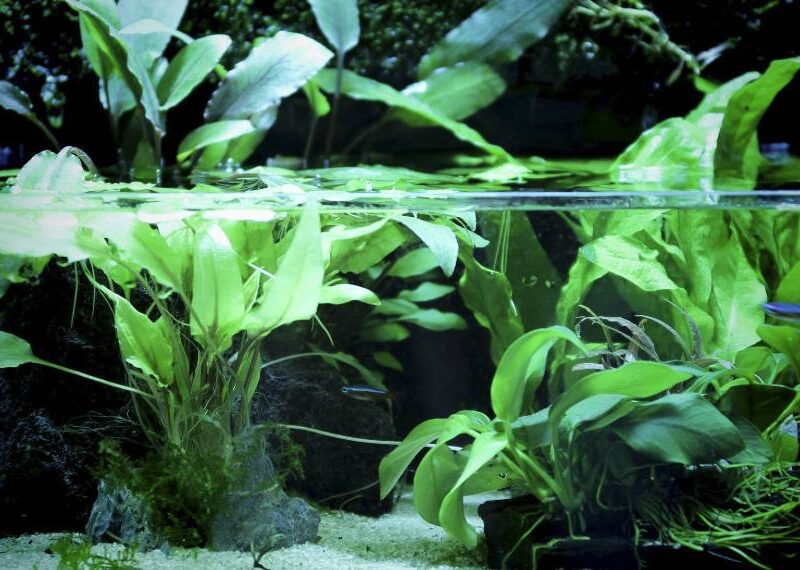Key Takeaways:
- Aquatic plants enhance the aesthetic appeal of a water garden, offering visually stunning displays.
- Aquatic plants create a balanced ecological system, providing habitats and food sources for various organisms.
- Aquatic plants improve water quality by filtering pollutants and stabilizing the temperature of the water.
- Low-maintenance aquatic plants are suitable for beginners.
- Blooming aquatic plants like water lilies and lotus add color to the water garden.
- Shade-tolerant aquatic plants like water iris and pickerel weed thrive in shaded areas.
- The addition of fish enhances ecological balance, adds movement, and controls pests in a water garden.
- Care and maintenance include proper planting techniques, nutrient supply, and algae control.
The Importance of Aquatic Plants in a Water Garden
1.1 Enhancing the Aesthetic Appeal of Your Water Garden
A water garden is a captivating and enchanting addition to any outdoor space. With its tranquil presence, it can transform an ordinary backyard into a serene oasis. Central to the beauty of a water garden are aquatic plants, which play a crucial role in enhancing its aesthetic appeal. These plants come in a variety of shapes, sizes, and colors, offering endless possibilities for creating visually stunning displays.
Imagine vibrant lily pads floating on the surface, delicate water hyacinths blooming with enchanting flowers, and tall and statuesque cattails swaying gently in the breeze. Each plant adds its own unique charm, creating a visually pleasing tapestry that can be admired and enjoyed from all angles. Whether your style leans towards a wild and natural look or a more formal arrangement, incorporating aquatic plants will elevate the beauty of your water garden to new heights.
1.2 Creating a Balanced Ecological System
Aquatic plants are not only aesthetically pleasing but also essential for creating a balanced ecological system within your water garden. They form the foundation of a healthy and thriving ecosystem, providing vital habitats and food sources for a wide range of organisms.
Submerged plants, such as oxygenators, release oxygen into the water, which is crucial for the survival of fish and other aquatic creatures. They also absorb excess nutrients, preventing the growth of algae and maintaining water clarity. Floating plants, like water lettuce and water lilies, provide shade and shelter for fish, while emergent plants, including cattails and rushes, offer nesting sites for birds and insects.
By incorporating a diverse range of aquatic plants, you can create a self-sustaining ecosystem that supports and nurtures its inhabitants. From tiny microorganisms to larger aquatic animals, each organism plays a valuable role in maintaining the delicate balance of your water garden.
1.3 Promoting Healthy Water Quality
Another significant benefit of aquatic plants in a water garden is their ability to improve water quality. They act as natural filters, removing harmful pollutants and toxins and reducing the levels of nitrates and phosphates that can lead to water pollution.
Through a process called nutrient uptake, aquatic plants absorb these excess nutrients, which are byproducts of organic waste and fertilizers. By doing so, they help prevent algae blooms and maintain proper water chemistry. This benefits not only the plants themselves but also the other inhabitants of your water garden, such as fish, by providing them with a clean and healthy environment in which to thrive.
Aquatic plants also help to stabilize the water temperature by providing shade and reducing temperature fluctuations. This is particularly important for fish, as it helps to create a more stable and comfortable environment for them to thrive.
Choosing the Perfect Aquatic Plants for Your Water Garden
2.1 Low-Maintenance Aquatic Plants for Beginners
For those new to water gardening, selecting low-maintenance aquatic plants is a great way to ease into the hobby. These plants require minimal care and attention while still adding beauty and interest to your water garden.
One popular choice for beginners is the water lettuce (Pistia stratiotes), a floating plant that forms a rosette of lush green leaves. It is incredibly easy to grow and provides shade and shelter for fish while also helping to maintain water quality. Another low-maintenance option is the water hyacinth (Eichhornia crassipes), which produces beautiful lavender flowers and has long, feathery roots that dangle in the water, providing additional habitat for small organisms.
2.2 Colorful and Blooming Aquatic Plants
If you want to add a pop of color to your water garden, there are numerous blooming aquatic plants to choose from. Water lilies (Nymphaea spp.) are a timeless favorite, with their exquisite flowers in shades of white, pink, yellow, and red. These plants are available in a variety of sizes, making them suitable for large ponds or even small container gardens.
Lotus (Nelumbo spp.) is another stunning option. With their large and unique flowers held high above the water on long stalks, lotus plants create a dramatic focal point in any water garden. They are available in a range of colors, including pink, white, and yellow.
2.3 Aquatic Plants for Shady Areas in Your Water Garden
If you have areas of your water garden that are shaded, there are several aquatic plants that thrive in such conditions. One popular option is the water iris (Iris pseudacorus), which features vibrant yellow flowers and tall, sword-shaped leaves. It can be planted in both submerged and shallow water areas, making it a versatile choice for different parts of your water garden.
Another shade-tolerant plant is the pickerel weed (Pontederia cordata). Known for its attractive spikes of violet-blue flowers, this plant adds a splash of color to shaded corners of your water garden. It also provides valuable habitat for pollinators such as bees and butterflies.
The Benefits of Adding Fish to Your Water Garden
3.1 Enhancing the Ecological Balance of Your Water Garden
Adding fish to your water garden not only introduces movement and life but also helps enhance the ecological balance. Fish play an important role in the ecosystem by consuming mosquito larvae, algae, and other unwanted pests. They act as natural pest controllers, reducing the need for chemical interventions.
Certain fish species, such as koi and goldfish, also play a part in maintaining a healthy water garden by stirring up the bottom substrate as they forage for food. This promotes better circulation and helps prevent the buildup of organic matter, which can lead to poor water quality if left unchecked.
3.2 Adding Extra Movement and Life to Your Water Garden
Watching fish gracefully swim through the water is a captivating sight that adds an extra dimension of movement and life to your water garden. Their colorful patterns and playful behaviors can bring a sense of joy and tranquility to any observer. Whether you choose vibrant koi fish, elegant goldfish, or smaller tropical species, their presence will undoubtedly make your water garden come alive.
Furthermore, the interaction between fish and aquatic plants creates a dynamic ecosystem. Fish provide fertilization for the plants through their waste, while the plants offer shade and shelter for the fish. This symbiotic relationship contributes to the overall health and vitality of your water garden.
3.3 Maintaining a Natural Pest Control System with Fish
In addition to their aesthetic appeal, fish in a water garden serve a valuable purpose as natural pest controllers. Mosquitoes are not only annoying but can also carry diseases, making them a concern for many homeowners. By introducing fish, such as mosquito fish (Gambusia affinis), which feed on mosquito larvae, you can significantly reduce the mosquito population in your surroundings.
Furthermore, the presence of fish can help deter unwanted species, such as frogs and birds, from inhabiting your water garden. Their constant movement and activity create an unpredictable environment that can discourage these creatures from settling in.
Essential Care and Maintenance Tips for Aquatic Plants
4.1 Proper Planting Techniques for Aquatic Plants
Successful growth and establishment of aquatic plants begin with proper planting techniques. Start by selecting the appropriate containers or planters, ensuring they have drainage holes to prevent waterlogging. This is especially crucial for potted aquatic plants.
When planting submerged or oxygenating plants, gently place them at the desired depth, allowing their foliage to float freely. For floating plants, simply release them onto the water’s surface, making sure they have enough space to grow and spread. Emergent plants should be planted in shallow areas, with their roots submerged in water and their shoots emerging out of the water.
4.2 Providing Adequate Nutrients and Fertilization
Aquatic plants require nutrients to thrive, and providing them with adequate nutrition is essential for their health and growth. One way to ensure this is by incorporating a layer of nutrient-rich substrate or soil at the bottom of your water garden. This provides a steady supply of essential minerals and nutrients.
Additionally, fertilizing your aquatic plants with a specialized aquatic plant fertilizer can significantly boost their growth and blooming potential. These fertilizers are specially formulated to provide the necessary nutrients without causing harm to the aquatic ecosystem.
4.3 Controlling Algae Growth in Your Water Garden
Algae growth is a common concern in water gardens, as it can quickly become unsightly and negatively impact the overall health of your aquatic plants. To control algae growth, it is crucial to maintain a balance of nutrients in the water.
Regular maintenance practices, such as removing excess debris, limiting overfeeding of fish, and using a skimmer or net to skim off any floating algae, can help prevent its excessive growth. Additionally, incorporating a variety of submerged and floating aquatic plants can help to outcompete algae for nutrients and inhibit its growth.
In some cases, the use of algae control products may be necessary. However, it is essential to use these products responsibly and according to the manufacturer’s instructions to avoid any harm to the plants, fish, or other organisms in your water garden.
Creating a serene and stunning water garden is an art form that requires careful consideration and planning. By understanding the importance of aquatic plants in your water garden, selecting the perfect plants for your specific needs, and incorporating fish to enhance the ecosystem, you can create a captivating and harmonious space.
Remember to provide proper care and maintenance to your aquatic plants, ensuring they receive the right nutrients and avoiding the overgrowth of algae. With patience, dedication, and a love for nature, your water garden will flourish, providing you with endless joy and tranquility for years to come.
FAQ
Question 1: What are the benefits of aquatic plants in a water garden?
Answer: Aquatic plants enhance the aesthetic appeal of a water garden and create a balanced ecological system by providing habitats and food sources for various organisms. They also improve water quality by filtering pollutants and stabilizing the temperature of the water.
Question 2: What types of low-maintenance aquatic plants are suitable for beginners?
Answer: Water lettuce and water hyacinth are popular choices for beginners as they require minimal care and attention while adding beauty to the water garden. Water lettuce provides shade and shelter for fish, while water hyacinth produces beautiful flowers and additional habitat for small organisms.
Question 3: What are some colorful and blooming aquatic plants?
Answer: Water lilies and lotus are excellent choices for adding a pop of color to a water garden. Water lilies come in shades of white, pink, yellow, and red, while lotus plants have large and unique flowers in colors such as pink, white, and yellow.
Question 4: What aquatic plants thrive in shaded areas?
Answer: Water iris and pickerel weed are two aquatic plants that thrive in shaded areas. Water iris features vibrant yellow flowers and tall, sword-shaped leaves, while pickerel weed adds a splash of color with its spikes of violet-blue flowers.
Question 5: Why is adding fish to a water garden beneficial?
Answer: Adding fish enhances the ecological balance of a water garden by controlling pests, stirring up the bottom substrate to promote circulation, and providing movement and life to the garden.
Question 6: How do fish contribute to maintaining a natural pest control system in a water garden?
Answer: Fish, such as mosquito fish, feed on mosquito larvae, reducing the mosquito population in the area. The constant movement and activity of fish also discourage unwanted species, such as frogs and birds, from inhabiting the water garden.
Question 7: What are some essential care and maintenance tips for aquatic plants?
Answer: Proper planting techniques include selecting the appropriate containers and planting submerged, floating, and emergent plants at the correct depths. Providing adequate nutrients through substrate, soil, and fertilization is crucial. Controlling algae growth can be achieved through regular maintenance, limiting the overfeeding of fish, and using a variety of aquatic plants.
Question 8: How do aquatic plants improve water quality in a water garden?
Answer: Aquatic plants act as natural filters, removing pollutants and toxins from the water. They also absorb excess nutrients, prevent algae blooms, and help stabilize water temperature.







